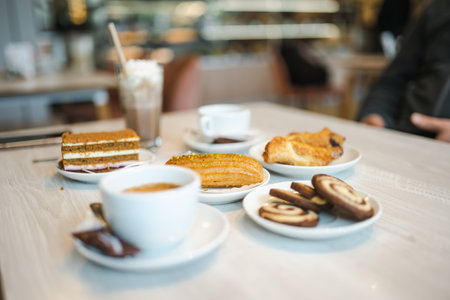Introduction to British Dessert-Inspired Coffee Syrups
Classic British desserts hold a cherished place in the nation’s culinary heritage, bringing warmth and comfort to countless homes and gatherings. From the humble sticky toffee pudding to the zesty zing of lemon drizzle cake, these puddings and sweets evoke nostalgia and a sense of togetherness, making them much more than just afters. Their distinctive flavours—whether it’s the deep caramel notes of treacle tart or the aromatic spice of bread and butter pudding—are instantly recognisable and beloved across generations. Translating these iconic tastes into coffee syrups is both a creative challenge and a delightful opportunity. The robust base of coffee can be elevated with nuanced layers inspired by these desserts, offering a uniquely British twist to your daily brew. Experimenting with dessert-inspired syrups not only pays homage to traditional favourites but also celebrates the spirit of innovation that defines contemporary British food culture. By capturing the essence of these classics in syrup form, we invite new ways to savour familiar comforts, whether enjoyed at home or shared amongst friends in a local café.
2. Selecting Iconic British Desserts for Syrup Inspiration
To authentically capture the essence of British café culture in your homemade coffee syrups, its essential to start with desserts that are both iconic and universally beloved across the UK. By drawing inspiration from classic puddings and treats, you can create unique syrups that instantly evoke a sense of nostalgia and comfort in every cup. The key is to identify which desserts translate well into syrup flavours, considering both their characteristic tastes and aromatic profiles.
Classic British Desserts as Flavour Bases
The following table outlines some of the most recognisable British desserts that serve as excellent bases for syrup experimentation:
| Dessert | Defining Flavours | Syrup Potential |
|---|---|---|
| Bakewell Tart | Almond, raspberry jam, buttery pastry | Rich nutty sweetness with fruity notes, perfect for lattes or flat whites |
| Sticky Toffee Pudding | Toffee, dates, dark sugar, vanilla | Deep caramelised syrup ideal for cappuccinos or mochas |
| Eton Mess | Strawberries, meringue, whipped cream | Light and fruity with a hint of creamy sweetness—refreshing in iced coffees |
| Lemon Drizzle Cake | Lemon zest, sweet sponge cake | Zesty citrus brightness complements both hot and cold brews |
| Bread and Butter Pudding | Custard, nutmeg, sultanas, buttered bread | Warm spiced undertones suited to winter coffee blends |
Why These Desserts?
These puddings have stood the test of time on British tables because they balance sweetness with subtle complexity—qualities that adapt beautifully to the world of coffee. Each offers a distinct flavour profile: Bakewell tart’s almondy richness appeals to those who enjoy marzipan notes; sticky toffee pudding delivers indulgent depth; Eton mess provides a lively fruitiness; while lemon drizzle cake brings a sharp yet sweet zing. Bread and butter pudding adds a cosy spiced element often associated with traditional tearooms.
Matching Flavours to Coffee Styles
When planning your syrup making, consider not only the dessert’s flavours but also how they will pair with different types of coffee. For instance, robust espresso-based drinks benefit from bold syrups like sticky toffee pudding, whereas lighter filter coffees may be better complemented by delicate fruit-forward syrups such as Eton mess. The aim is to enhance—not overpower—the underlying coffee experience while paying homage to Britain’s rich dessert heritage.

3. Balancing Flavours: Translating Pudding to Cup
To truly evoke the nostalgia of classic British desserts in your coffee syrups, you must first distil their signature flavours into a form that works harmoniously with coffee. This means identifying the key components—think buttery sponges, silky custards, and bright fruity notes—and finding ways to express them using accessible ingredients. For example, to capture the essence of a Victoria sponge, combine vanilla extract for the cake’s soft sweetness and a hint of strawberry or raspberry concentrate to represent the jam layer. For bread and butter pudding, a blend of brown sugar syrup, gentle cinnamon, and a dash of nutmeg can mirror those comforting custardy undertones without overpowering your brew.
When working with fruit-forward puddings like Eton Mess or Bakewell tart, balance is critical. Too much fruit syrup will mask the subtlety of good coffee, while too little won’t bring out that unmistakable British character. Use concentrated fruit purees or carefully reduced jams for depth, offset with almond extract if you’re evoking Bakewell’s marzipan twist. Keep sweetness in check—a touch more than usual may be needed to mimic dessert profiles, but always taste as you go. By layering these elements thoughtfully, you’ll craft syrups that complement rather than compete with coffee, giving each cup a true pudding-inspired personality.
4. Step-by-Step: Making British Dessert Flavoured Syrups
Transforming your favourite British desserts into coffee syrups is a rewarding kitchen experiment that blends tradition with creativity. Here’s a pragmatic guide to crafting these delightful syrups, focusing on essential pantry staples found in British kitchens, such as golden syrup and clotted cream.
Gathering Your Ingredients
Start with high-quality ingredients for an authentic flavour. Pantry staples like golden syrup bring a warm, buttery sweetness, while clotted cream adds rich, silky depth. Don’t overlook classic British spices—think nutmeg, cinnamon, or ginger—that echo the notes found in beloved puddings and cakes.
| Ingredient | Role in Syrup | Common British Examples |
|---|---|---|
| Sugar | Main sweetener and thickener | Caster sugar, demerara sugar |
| Golden syrup | Adds caramel notes and viscosity | Lyle’s Golden Syrup |
| Cream/Dairy | Enriches texture and mouthfeel | Clotted cream, double cream |
| Spices & Extracts | Provide signature dessert flavour | Cinnamon, nutmeg, vanilla extract |
| Citrus/Preserves | Add brightness and complexity | Lemon zest, orange marmalade |
Practical Steps for Syrup-Making
- Simmer the Base: Combine equal parts sugar and water (or a mix of water and golden syrup) in a saucepan. Bring gently to a simmer over low heat until the sugar dissolves completely.
- Add Flavour Elements: Stir in your chosen dessert-inspired ingredients. For example, add a spoonful of clotted cream for richness or infuse with citrus peel for zesty brightness. Spices should be added at this stage to allow flavours to develop fully.
- Simmer and Infuse: Let the mixture bubble gently for 10-15 minutes. If using dairy like clotted cream, keep the heat low to avoid curdling. Taste occasionally and adjust sweetness or intensity as desired.
- Strain and Cool: Remove from heat and strain through a fine sieve or muslin cloth to achieve a smooth syrup free of solids.
- Bottle and Store: Pour into sterilised bottles. Most homemade syrups will keep refrigerated for up to two weeks.
Useful Kitchen Tips for Success
- Sterilise Bottles: To maximise shelf life, always use clean, sterilised bottles or jars for storage.
- Taste as You Go: Flavour can intensify as the syrup cools; it’s wise to taste midway through simmering.
- Potion Control: Start with small batches to experiment with ratios before scaling up.
- Avoid Overheating Dairy: Gentle heat preserves the lushness of cream-based additions without splitting.
- Label Clearly: Especially if you’re making several varieties—clarity helps when reaching for the perfect syrup during your morning brew!
The Importance of British Staples in Syrup Crafting
The heart of these flavoured syrups lies in the authenticity of their core ingredients. Using golden syrup gives an unmistakable British character—think sticky toffee pudding or treacle tart—while clotted cream evokes memories of Cornish cream teas. By honouring these pantry classics, you can bottle up nostalgia and pour it straight into your next flat white or cappuccino.
5. Pairing and Serving Suggestions
Integrating classic British dessert-inspired syrups into your café repertoire isn’t just about the syrup itself—it’s about the harmony of flavours when paired with the right coffee and complementary treats. To truly evoke a British café experience, consider the following thoughtful pairing suggestions:
Coffee Pairings for Every Palate
Each syrup brings its own character, so matching them to suitable coffee styles is key. A syrup based on sticky toffee pudding, rich in caramel and date notes, pairs beautifully with a velvety flat white or a robust Americano, allowing the syrup’s sweetness to round out the coffee’s natural bitterness. Meanwhile, a lemon drizzle cake syrup shines in a lively filter coffee or even an iced latte—its zest balancing out darker roasts. For those partial to chocolatey treats like Black Forest gateau, try mixing the syrup into a mocha or cappuccino, enhancing the dessert-like experience without overpowering the drink’s espresso base.
Baked Treats for a Full British Experience
No British café moment is complete without a biscuit or slice of cake. Serve your flavoured coffees alongside shortbread fingers for buttery richness that echoes many classic puddings. Victoria sponge-flavoured syrup works wonders with actual Victoria sponge cake or even scones—double down on nostalgia and comfort. For autumnal vibes, pair gingerbread-inspired syrups with oat biscuits or parkin, creating a warming afternoon break.
Serving Tips and Presentation
To elevate your offering, serve these coffee creations in classic crockery—think sturdy mugs or delicate china for a touch of elegance. Garnish with grated nutmeg or a twist of citrus peel where it suits the syrup profile. For gatherings, consider a tasting flight: offer small cups of several flavoured coffees paired with bite-sized baked goods, inviting guests to discover their favourite combinations. Above all, encourage conversation around these flavour pairings—they’re as much about community as they are about culinary craft.
6. Honouring Tradition While Innovating
When embarking on the journey of transforming classic British desserts into coffee syrups, it’s crucial to strike a thoughtful balance between tradition and innovation. These beloved puddings—whether it’s sticky toffee, Bakewell tart, or Eton mess—carry with them centuries of culinary history and cultural identity. As we reinterpret their flavours for the modern coffee lover, taking care not to lose sight of their origins shows respect for Britain’s rich dessert heritage.
Each syrup you craft is more than just a flavouring; it’s an edible tribute to the stories and memories embedded in these sweets. Using authentic ingredients, such as real custard, treacle, or fruit preserves, pays homage to those who perfected these recipes long before us. Yet, inviting experimentation—perhaps blending rhubarb crumble notes with espresso or adding hints of malt to a banoffee-inspired syrup—keeps the process exciting and relevant.
What makes British desserts unique is their comforting simplicity paired with occasional indulgence: think of the warming spices in bread and butter pudding or the tartness of gooseberry fool. Capturing these distinctive qualities in your syrups means focusing on layered, recognisable flavours rather than overcomplicating things. It’s about celebrating nostalgia while introducing new experiences that fit seamlessly into contemporary café culture.
Ultimately, honouring tradition does not mean stifling creativity. Rather, it means ensuring that every innovative twist remains rooted in the essence of what makes British puddings so beloved. By respecting their origins while confidently exploring new pairings and methods, you keep both the heritage and the future of British dessert culture alive in every cup.


